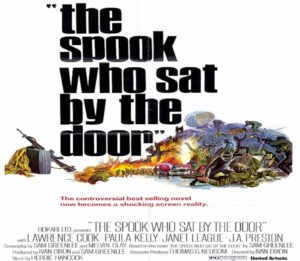Last night I continued my self-study into cinema’s sub-genre Blaxploitation with 1973’s The Spook Who Sat by the Door.
Based on the novel of the same name the story is about Dan Freeman who, after processed rigged to eliminate all of the class’s black candidates, becomes the CIA’s first black case officer. Despite his drive, talent, and intelligence, Dan is assigned menial office work and endures the agency’s entrenched racism. Eventually bitter with his treatment Dan resigned from the CIA and returns to his home of Chicago where he founds a social agency dedicated to rehabilitating black youth away from street-gang life. In reality systemic racism has radicalized Dan and his social work is a cover for his plans to take the training, skills, and knowledge he learned from the Agency and establish a national black liberation movement and guerrilla army. After usurping the gang of his youth, Dan trains the street kids in the specialized knowledge and tactics instilled in him by the U.S.  Government, fosters friendships with members of the police, all while maintaining his cover as a social worker. The film reaches its climax with the launching of the revolution and Dan’s confrontation with his past.
Government, fosters friendships with members of the police, all while maintaining his cover as a social worker. The film reaches its climax with the launching of the revolution and Dan’s confrontation with his past.
Not as well known as other entries into the sub-genre I discovered The Spook Who Sat by the Door while listening to podcasts. Unable to locate it on any streaming service and with the DVD unavailable through my rental services I gave in to temptation and purchased it new from Amazon. If I liked the film it could join my library and if I didn’t care for it my sweetie-wife could utilize her e-bay skills and resell the disc. The movie now resides in my library.
Now, that is not to say that this is a great movie, it suffers from a number of small flaws that hamper the execution, things that look like establishment of complications are dropped without any word or later use and the principal driving drama of the third act could have been better established but the film overcomes these relatively minor missteps and achieves a compelling and thoughtful narrative. Competent, if uninspired, direction by Ivan Dixon of Hogan’s Heroes carries the viewer through the combination of action and social commentary. Written by Sam Geeenlee, who also wrote the novel and served as producer of the film, and Melvin Clay, the screenplay does more than explore the white and black divide, taking time to explore some of the troubles within its community. Herbie Hancock provided the film’s electronic music giving the movie a different yet budget friendly sound.
All art is both a product and a reflection of the culture that produced it. This is especially true for Blaxploitation cinema. While there has always been a cinema for black audiences it is only after the Civil Rights Movement, the rise of the Producer Unit system of film production, and turmoil of the counter-culture than the fertile ground had been prepared could this revolutionary movement find both artistic and commercial success. The Spook Who Sat by the Door did not find financial success on its initial release and after being hastily pulled from distribution for many years this film was only available on bootleg tapes. The author and the director voiced opinions that United Artist has found the final product’s political message too upsetting as the reason for the films banishment into the forgotten archives. In 2004 actor Tim Reid located an original negative and arraigned for the DVD release and in 2012 The Spook Who Sat by the Door was included the National Film Registry of culturally significant movies.
